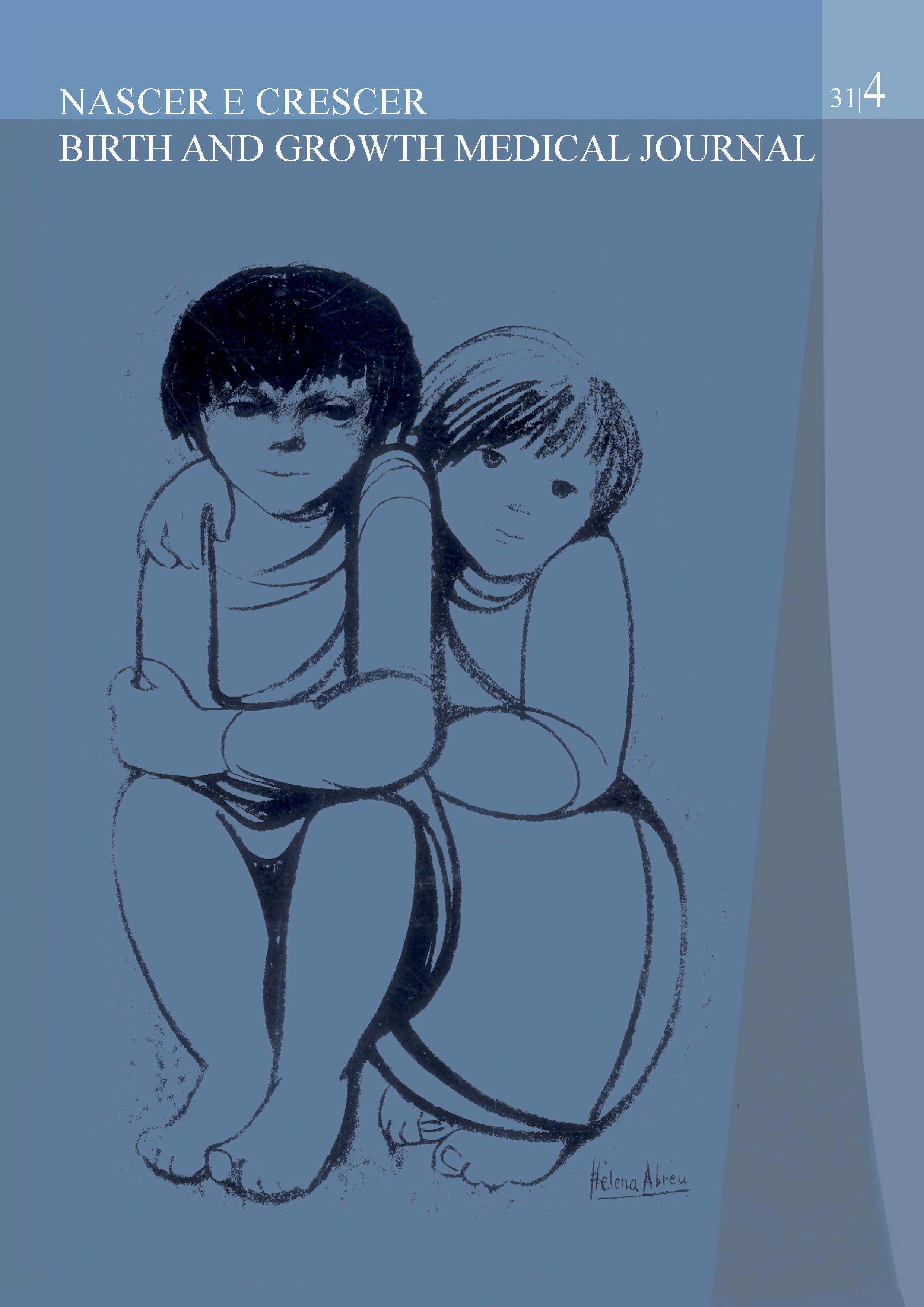Alterações endócrinas em crianças com neurofibromatose tipo 1: O que procurar?
DOI:
https://doi.org/10.25753/BirthGrowthMJ.v31.i4.25986Palavras-chave:
crescimento e desenvolvimento, doenças do sistema endócrino, neurofibromatose 1, PediatriaResumo
A neurofibromatose tipo 1 (NF1) é uma das doenças genéticas mais comuns, com uma incidência reportada de 1:3000. A condição é multissistémica e os critérios diagnósticos foram recentemente revistos como uma recomendação de consenso internacional. As características clínicas da doença evoluem lenta e progressivamente e frequentemente podem estar ausentes na primeira infância. Embora descritos há várias décadas nestas crianças, condições endócrinas e distúrbios do crescimento não estão incluídos nos critérios diagnósticos da doença. No entanto, são relativamente frequentes e podem ser a forma de apresentação de glioma da via ótica. Devido ao amplo espetro de implicações na saúde da NF1, o seguimento destas crianças é muitas vezes feito em contexto de consulta de Pediatria.
O objetivo deste artigo é rever os distúrbios endócrinos mais frequentes em doentes com NF1, o que vigiar e quando referenciar os doentes à consulta de Endocrinologia pediátrica.
Downloads
Referências
Legius E, Messiaen L, Wolkenstein P, Pancza P, Avery RA, Berman Y, et al. Revised diagnostic criteria for neurofibromatosis type 1 and Legius syndrome: an international consensus recommendation. Genet Med. 2021;23(8):1506-1513. doi: https://doi.org/10.1038/s41436-021-01170-5.
Hamosh A. Neurofibromatosis, type I; NF1, April, 2020. (Assessed august, 2021). Available at: https://www.omim.org/entry/162200.
Miller DT, Freedenberg D, Schorry E, Ullrich NJ, Viskochil D, Korf BR. Aap Council On Genetics, AAP American College Of Medical Genetics And Genomics. Health Supervision for Children With Neurofibromatosis Type 1. Pediatrics. 2019;143(5):e20190660. doi: https://doi.org/10.1542/peds.2019-0660.
Saxena KM. Endocrine manifestations of Neurofibromatosis children. Am J Dis Child. 1970;120(3):265-71. doi: https://doi.org/10.1001/archpedi.1970.02100080149020.
Giovannoni I, Callea F, Boldrini R, Inserra A, Cozza R, Francalanci P. Malignant Pheochromocytoma in a 16-Year-Old Patient with Neurofibromatosis Type 1. Pediatr Dev Pathol. 2014;17(2):126-9. doi: https://doi.org/10.2350/13-10-1397-CR.1.
Santoro C, Perrotta S, Picariello S, Scilipoti M, Cirillo M, Quaglietta L, et al. Pretreatment Endocrine Disorders Due to Optic Pathway Gliomas in Pediatric Neurofibromatosis Type 1: Multicenter Study. J Clin Endocrinol Metab. 2020;105(6):dgaa138. doi: https://doi.org/10.1210/clinem/dgaa138. PMID: 32294191.
Cambasio P, Galassi S, Palmiero M, Mastronuzzi A, Del Bufalo F, Capolino R, et al. Growth hormone excess in children with neurofibromatosis type-1 and optic glioma. Am J Med Genet. 2017;173(9):2353-8. doi: https://doi.org/10.1002/ajmg.a.38308.
Sani I, Albanese A. Endocrine Long-term Follow-up of Children with Neurofibromatosis type 1 and Optic Pathway Glioma. Horm Res Paediatr. 2017; 87:179-88. doi: https://doi.org/10.1159/000458525.
Cnossen MH, Stam EN, Cooiman L, Simonsz HJ, Stroink H, Oranje AP, et al. Endocrinological disorders and optic pathway glioma in children with neurofibromatosis. Pediatrics. 1997;100(4):667-70. doi: https://doi.org/10.1542/peds.100.4.667.
Carmi D, Shohat M, Metzker A, Dickerman Z. Growth, Puberty and endocrine function in patients with sporadic or familial Neurofibromatosis Type 1: a longitudinal study. Pediatrics. 1999;103(6 Pt 1):1257-62. doi: https://doi.org/10.1542/peds.103.6.1257.
Bizzarri C, Bottaro G. Endocrine implications of neurofibromatosis 1 in Childhood. Horm Res Paediatr. 2015;83(4):232-41. doi: https://doi.org/10.1159/000369802.
Kyritsi EM, Hasiotou M, Kanaka-Gantenbein C. Partial empty sella syndrome, GH deficiency and transient central adrenal insufficiency in a patient with NF1. Endocrine. 2020;69(2):377-85. doi: https://doi.org/10.1007/s12020-020-02351-z.
Clementi M, Milani S, Mammi I, Boni S, Monciotti C, Tenconi R. Neurofibromatosis Type 1 Growth Charts. Am J Med Genet. 1999; 87:317–23. doi: https://doi.org/10.1002/(SICI)1096-8628(19991203)87:4<317::AID-AJMG7>3.0.CO;2-X.
Bruzzi P, Sani I, Albanese A. Reversible Growth Hormone Excess in Two Girls with Neurofibromatosis Type 1 and Optic Pathway Glioma. Horm Res Paediatr 2015;84(6):414–22. doi: 10.1159/000440956.
Habiby R, Silverman B, Listernick R, Charrow J. Precocious puberty in children with neurofibromatosis type 1. J Pediatr. 1997;131(5):786-7. doi: https://doi.org/10.1016/s0022-3476(95)70449-3.
Bartolini E, Stagi S, Scalini P, Bianchi A, Ciccarone A, Mascalchi M. Central precocious puberty due to hypothalamic hamartoma in neurofibromatosis type 1. Hormones (Athens). 2016;15(1):144-6. doi: https://doi.org/10.14310/horm.2002.1631.
Kocova M, Kochova E, Sukarova-Angelovska E. Optic glioma and precocious puberty in a girl with neurofibromatosis type 1 carrying an R681X mutation of NF1: case report and review of the literature. BMC Endocrine Disorders. 2015;15:82-6. doi: https://doi.org/10.1186/s12902-015-0076-4.
Howell SJ, Wilton P, Lindberg A, Shaleta SM. Growth Hormone and Neurofibromatosis. Horm Res 2000;53(suppl 1):70–6. doi: https://doi.org/10.1159/000053208.
Josefson J, Listernick R, Fangusaro JR, Charrow J, Habiby R. Growth Hormone Excess in Children with Neurofibromatosis Type 1-Associated and Sporadic Optic Pathway Tumors. J Pediatr 2011;158(3):433-6. doi: https://doi.org/10.1016/j.jpeds.2010.09.013.
Neurofibromatosis conference statement. National Institutes of Health Consensus Development Conference. Arch. Neurol. 1988; 45: 575–8.
Downloads
Publicado
Como Citar
Edição
Secção
Licença
Direitos de Autor (c) 2022 Maria Adriana Rangel, Marta Vila Real, Fátima Santos, Ana Luísa Leite, Rosa Arménia Campos

Este trabalho encontra-se publicado com a Creative Commons Atribuição-NãoComercial 4.0.
Copyright and access
This journal offers immediate free access to its content, following the principle that providing free scientific knowledge to the public provides greater global democratization of knowledge.
The works are licensed under a Creative Commons Attribution Non-commercial 4.0 International license.
Nascer e Crescer – Birth and Growth Medical Journal do not charge any submission or processing fee to the articles submitted.


